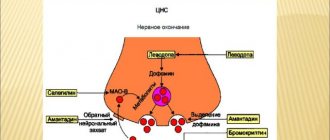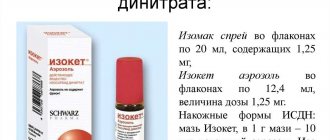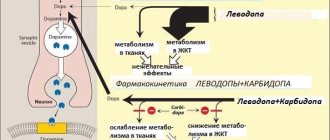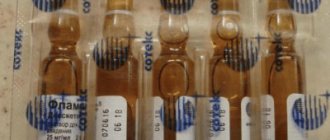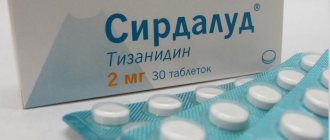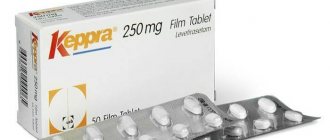Release form and composition
Dosage form - tablets: round, almost white or white (10 pieces in a blister, 1, 2, 3, 5 or 10 blisters in a cardboard pack):
- 80 mg – one side is convex, with “SOT” engraved, on the other side the surface of the tablet is beveled towards the dividing line;
- 160 mg – biconvex, with “SOT” engraved on one side and a score on the other.
1 tablet contains:
- active ingredient: sotalol hydrochloride – 80 mg or 160 mg;
- auxiliary components: colloidal silicon dioxide, hyprolose, lactose monohydrate, sodium carboxymethyl starch, corn starch, magnesium stearate.
Composition of the drug
“Sotalol” is the internationally accepted international name for the drug “Sotahexal”. Analogues may have different but similar antiarrhythmic effects. Sotahexal contains sotalol hydrochloride as the main active ingredient. In addition, it includes a small amount of auxiliary components. Among them are cellulose, lactose monohydrate, corn starch, magnesium stearate and other binders.
The shelf life of tablets or injection solution is 5 years.
Pharmacological properties
Pharmacodynamics
Sotalol is a non-selective beta-adrenergic receptor blocker, the action of which extends to b1 and b2 receptors. This substance does not have its own membrane-stabilizing and sympathomimetic activity. Sotalol is able to suppress renin secretion, and this effect is pronounced both during exercise and at rest.
The β-adrenergic blocking effect of Sotahexal leads to a decrease in heart rate and a limited decrease in the strength of heart contractions. These changes lead to a decrease in the volume of load on the heart and a decrease in the myocardial oxygen demand.
The antiarrhythmic effect of sotalol is associated with the ability to prolong the myocardial action potential, as well as the ability to block beta-adrenergic receptors. Sotalol increases the duration of effective refractory periods in the impulse pathways (atrial, ventricular and accessory).
Pharmacokinetics
When taken orally, the bioavailability of the drug exceeds 90%. The maximum concentration in the blood plasma is observed after 2.5–4 hours, the equilibrium concentration is within 2–3 days. When taken on an empty stomach, the absorption of the drug is approximately 20% higher compared to taking the drug with food. In the dose range of 40–640 mg/day, the concentration of sotalol in plasma is proportional to the doses taken. Distribution of the substance occurs in plasma, peripheral tissues and organs. The half-life is from 10 to 20 hours.
Sotalol does not bind to plasma proteins and is not metabolized. The pharmacokinetics of the 1- and d-enantiomers of sotalol are almost the same.
The drug penetrates the blood-brain barrier poorly, and its concentration in the cerebrospinal fluid is approximately 10% of the concentration in the blood plasma.
The main volume of the drug is excreted through the kidneys, with 80–90% of the dose excreted unchanged in the urine, and the rest in the feces.
Instructions:
Clinical and pharmacological group
01.001 (Beta1-, beta2-blocker)
Release form, composition and packaging
Tablets are white or almost white, round, convex on one side with the engraving “SOT”; on the other side there is a line, the surface of the tablet is beveled towards the line.
| 1 tab. | |
| sotalol hydrochloride | 80 mg |
Excipients: lactose monohydrate, corn starch, hyprolose, sodium carboxymethyl starch, colloidal silicon dioxide, magnesium stearate.
10 pieces. - blisters (1) - cardboard packs. 10 pcs. - blisters (2) - cardboard packs. 10 pcs. - blisters (3) - cardboard packs. 10 pcs. - blisters (5) - cardboard packs. 10 pcs. - blisters (10) - cardboard packs.
The tablets are white or almost white, round, biconvex, scored on one side and engraved “SOT” on the other.
| 1 tab. | |
| sotalol hydrochloride | 160 mg |
Excipients: lactose monohydrate, corn starch, hyprolose, sodium carboxymethyl starch, colloidal silicon dioxide, magnesium stearate.
10 pieces. - blisters (1) - cardboard packs. 10 pcs. - blisters (2) - cardboard packs. 10 pcs. - blisters (3) - cardboard packs. 10 pcs. - blisters (5) - cardboard packs. 10 pcs. - blisters (10) - cardboard packs.
pharmachologic effect
Beta1-, beta2-adrenergic blocker. Sotalol is a non-selective blocker of β1-, β2-adrenergic receptors that does not have its own sympathomimetic and membrane-stabilizing activity. Like other beta-blockers, sotalol suppresses renin secretion, and this effect is pronounced both at rest and during exercise. The beta-adrenergic blocking effect of the drug causes a decrease in heart rate (negative chronotropic effect) and a limited decrease in the force of heart contractions (negative inotropic effect). These changes in cardiac function reduce myocardial oxygen demand and the amount of workload on the heart.
The antiarrhythmic properties of sotalol are associated both with the blockade of β-adrenergic receptors and with the prolongation of the myocardial action potential. The main effect of sotalol is to increase the duration of effective refractory periods in the atrial, ventricular and accessory impulse pathways.
Pharmacokinetics
Suction
Bioavailability when taken orally is almost complete (more than 90%). Cmax in blood plasma is achieved 2.5-4 hours after oral administration. Absorption of the drug is reduced by approximately 20% when taken with food compared to when taken on an empty stomach. In the dose range from 40 to 640 mg/day, the concentration of sotalol in the blood plasma is proportional to the dose taken.
Distribution
Distribution occurs in the plasma, as well as in peripheral organs and tissues. Css is achieved within 2-3 days. Sotalol does not bind to plasma proteins.
It penetrates the BBB poorly, and its concentration in the cerebrospinal fluid is only 10% of the concentration in the blood plasma.
Metabolism
Not metabolized. The pharmacokinetics of the d- and l-enantiomers of sotalol are almost the same.
Removal
The main route of elimination from the body is through the kidneys. From 80 to 90% of the administered dose is excreted unchanged in the urine, and the rest in the feces. T1/2 is 10-20 hours.
Pharmacokinetics in special clinical situations
Patients with impaired renal function should be prescribed lower doses of the drug.
With age, pharmacokinetics change slightly, although impaired renal function in elderly patients reduces the rate of excretion, which leads to increased accumulation of the drug in the body.
Dosage
The drug is taken orally 1-2 hours before meals, without chewing, with a sufficient amount of liquid.
Simultaneous ingestion of food (especially milk and dairy products) reduces the absorption of the drug.
The dose of the drug is selected individually depending on the severity of the disease and the patient’s response to treatment.
The initial dose is 80 mg/day. If the therapeutic effect is insufficient, the dose can be gradually increased to 240-320 mg/day, divided into 2-3 doses. In most patients, the therapeutic effect is achieved at a total daily dose of 160-320 mg, divided into 2 doses.
For life-threatening severe arrhythmias, the dose may be increased to a maximum of 480 mg, divided into 2 or 3 separate doses. However, such doses should only be prescribed in cases where the potential benefit outweighs the risk of side effects, especially proarrhythmogenic effects.
Patients with impaired renal function are at risk of developing cumulation, so they need to monitor blood pressure and heart rate (not lower than 50 beats/min). Since sotalol is excreted from the body mainly by the kidneys, and its T1/2 increases in renal failure, the dosage of the drug should be reduced when the serum creatinine level is more than 120 μmol/L in accordance with the following recommendations:
| Serum creatinine | Recommended dose | |
| µmol/l | mg/dl | |
| < 120 | <1.2 | Usual dose |
| 120-200 | 1.2-2.3 | 3/4 of the usual dose |
| 200-300 | 2.3-<3.4 | 1/2 the usual dose |
| 300-500 | 3.4-5.7 | 1/4 usual dose |
In case of severe renal failure, it is necessary to regularly monitor the ECG and the concentration of the drug in the blood serum.
The duration of therapy is determined by the attending physician.
If the patient forgot to take the pill on time, next time you should not take an additional amount of the drug, you should only take the prescribed amount of Sotahexal.
Overdose
Symptoms: decreased blood pressure, bradycardia, bronchospasm, hypoglycemia, loss of consciousness, generalized seizures, ventricular tachycardia; in severe cases - symptoms of cardiogenic shock, asystole.
Treatment: gastric lavage, hemodialysis, administration of activated carbon. Symptomatic therapy: atropine - 1-2 times intravenously; glucagon - first in the form of a short IV infusion at a dose of 0.2 mg/kg body weight, then at a dose of 0.5 mg/kg body weight IV infusion over 12 hours.
Drug interactions
When taking slow calcium channel blockers such as verapamil and diltiazem simultaneously, a decrease in blood pressure may occur as a result of worsening contractility. IV administration of these drugs should be avoided while using sotalol (except in cases of emergency medicine).
The combined use of class IA antiarrhythmic drugs (especially quinidine type: disopyramide, quinidine, procainamide) or class III (for example, amiodarone) can cause a pronounced prolongation of the QT interval. Drugs that prolong the QT interval should be used with caution with drugs that prolong the QT interval, such as class I antiarrhythmics, phenothiazines, tricyclic antidepressants, terfenadine and astemizole, and some quinolone antibiotics.
When taking nifedipine and other 1,4-dihydropyridine derivatives simultaneously, a decrease in blood pressure is possible.
The simultaneous administration of norepinephrine or MAO inhibitors, as well as abrupt withdrawal of clonidine, can cause arterial hypertension. In this case, withdrawal of clonidine should be carried out gradually and only a few days after stopping Sotahexal.
Tricyclic antidepressants, barbiturates, phenothiazines, opioids, antihypertensives, diuretics, and vasodilators can cause a sharp decrease in blood pressure.
The use of inhalation anesthesia, incl. tubocurarine while taking Sotahexal increases the risk of suppression of myocardial function and the development of arterial hypotension.
With the simultaneous use of Sotahexal with reserpine, clonidine, alpha-methyldopa, guanfacine and cardiac glycosides, severe bradycardia and a slowdown in the conduction of excitation in the heart may develop.
Beta blockers may potentiate withdrawal hypertension following discontinuation of clonidine, so beta blockers should be discontinued gradually, several days before tapering clonidine.
Prescribing insulin or other oral hypoglycemic agents, especially during physical activity, can lead to increased hypoglycemia and the manifestation of its symptoms (increased sweating, rapid pulse, tremor). In case of diabetes mellitus, dose adjustment of insulin and/or hypoglycemic drugs is necessary.
Potassium-sparing diuretics (for example, furosemide, hydrochlorothiazide) can provoke arrhythmias caused by hypokalemia.
When used concomitantly with Sotahexal, the use of higher doses of beta-agonists such as salbutamol, terbutaline and isoprenaline may be required.
Use during pregnancy and lactation
Taking Sotahexal during pregnancy, especially in the first 3 months, is possible only for vital indications and with a careful balance of all risk factors.
In the case of therapy during pregnancy, the drug should be discontinued 48-72 hours before the expected due date due to the possibility of bradycardia, arterial hypotension, hypokalemia and respiratory depression in newborns.
Sotalol passes into breast milk and reaches effective concentrations there. If it is necessary to prescribe the drug during breastfeeding, breastfeeding should be stopped.
Side effects
From the cardiovascular system: bradycardia, shortness of breath, chest pain, palpitations, AV block, increased symptoms of heart failure, palpitations, edema, fainting, arrhythmogenic effect, decreased blood pressure; rarely - increased angina attacks.
From the digestive system: nausea, vomiting, diarrhea, constipation, dry mouth, abdominal pain, flatulence.
From the side of the central nervous system: headache, dizziness, increased fatigue, depression, anxiety, mood changes, tremor, asthenia, sleep disturbances (drowsiness or insomnia), depression, paresthesia in the extremities.
From the senses: visual impairment, inflammation of the cornea and conjunctiva (should be taken into account when wearing contact lenses), decreased tear production, impaired hearing, and taste sensations.
From the endocrine system: hypoglycemia (most likely in patients with diabetes mellitus or in strict diets).
From the respiratory system: bronchospasm (especially in case of impaired pulmonary ventilation).
From the genitourinary system: decreased potency.
Dermatological reactions: skin rash, itching, redness, psoriasiform dermatosis, alopecia, urticaria.
Laboratory indicators: elevated results in photometric urine analysis for metanephrine (O-methyladrenaline).
Other: cold extremities, muscle weakness, cramps, fever.
Storage conditions and periods
The drug should be stored out of the reach of children at a temperature not exceeding 25°C. Shelf life: 5 years.
Indications
Symptomatic and chronic heart rhythm disturbances:
- ventricular tachycardia, incl. supraventricular tachycardia in Wolff-Parkinson-White syndrome;
- ventricular extrasystole;
- paroxysmal form of atrial fibrillation.
Contraindications
— chronic heart failure stage IIB-III;
- cardiogenic shock;
- AV blockade of II or III degree;
- sinoatrial block;
— sick sinus syndrome;
— severe bradycardia (heart rate less than 50 beats/min);
- congenital or acquired long QT interval syndrome;
- arterial hypotension (systolic blood pressure less than 90 mm Hg);
- obliterating vascular diseases;
- bronchial asthma or COPD;
- metabolic acidosis;
- pheochromocytoma without simultaneous administration of alpha-blockers;
- acute myocardial infarction;
— renal failure (creatinine clearance less than 10 ml/min);
- general anesthesia that causes suppression of myocardial function (for example, cyclopropane or trichlorethylene);
- tachycardia of the “pirouette” type;
- severe allergic rhinitis;
- simultaneous use of MAO inhibitors;
- lactation period;
- age under 18 years (efficacy and safety have not been established);
- hypersensitivity to sotalol, sulfonamides and other components of the drug.
Caution should be exercised when prescribing Sotahexal to patients who have recently suffered a myocardial infarction, with diabetes mellitus, psoriasis, renal dysfunction, AV blockade of the first degree, with water-electrolyte imbalance (hypomagnesemia, hypokalemia), thyrotoxicosis, depression (incl. and history), with prolongation of the QT interval, in elderly patients.
Use with extreme caution when there is a history of allergic reactions, as well as against the background of desensitizing therapy, because sotalol suppresses sensitivity to allergens.
special instructions
Caution should be exercised when prescribing Sotahexal to patients:
- with a history of diabetes mellitus with pronounced fluctuations in blood glucose levels, as well as following strict diets;
- for pheochromocytoma (simultaneous administration of alpha-blockers is necessary);
- if you have a history or family history of psoriasis;
- in case of impaired renal function;
- old age.
Treatment with the drug is carried out under the control of heart rate, blood pressure, and ECG. If there is a pronounced decrease in blood pressure or a decrease in heart rate, the daily dose should be reduced.
Patients with impaired renal function require dosage adjustment.
Cancellation of Sotahexal should be done under the supervision of the attending physician and gradually (especially after long-term use).
Sotahexal should not be used in patients with hypokalemia or hypomagnesemia until the existing disorders are corrected. These conditions may increase the degree of prolongation of the QT interval and increase the likelihood of developing TRI. Monitoring of electrolyte balance and acid-base status is necessary in patients with severe or prolonged diarrhea and in patients receiving medications that cause a decrease in magnesium and/or potassium levels in the body.
In thyrotoxicosis, sotalol may mask certain clinical signs of thyrotoxicosis (eg, tachycardia). Abrupt withdrawal in patients with thyretoxicosis is contraindicated, as it can increase the symptoms of the disease.
When prescribing beta-blockers to patients receiving hypoglycemic agents, caution should be exercised, since during long breaks in food intake, hypoglycemia may develop, and its symptoms, such as tachycardia or tremor, may be masked by the action of the drug.
Use for renal impairment
Patients with impaired renal function are at risk of developing cumulation, so they need to monitor blood pressure and heart rate (not lower than 50 beats/min). Since sotalol is excreted primarily through the kidneys and its half-life is increased in the presence of renal failure, the dosage of the drug should be reduced if the serum creatinine level is more than 120 μmol/L in accordance with the following recommendations and:
| Serum creatinine | Recommended dose | |
| µmol/l | mg/dl | |
| < 120 | <1.2 | Usual dose |
| 120-200 | 1.2-2.3 | 3/4 of the usual dose |
| 200-300 | 2.3-<3.4 | 1/2 the usual dose |
| 300-500 | 3.4-5.7 | 1/4 usual dose |
In case of severe renal failure, it is necessary to regularly monitor the ECG and the level of drug concentration in the blood serum.
Conditions for dispensing from pharmacies
The drug is available with a prescription.
Contraindications
Absolute:
- acute myocardial infarction;
- chronic heart failure stage IIB-III;
- sinoatrial (SA) block;
- cardiogenic shock;
- tachycardia of the “pirouette” type;
- atrioventricular (AV) block II-III degree;
- severe bradycardia with a heart rate (HR) less than 50 beats per minute;
- sick sinus syndrome;
- long QT syndrome (congenital or acquired);
- arterial hypotension with systolic blood pressure (BP) below 90 mmHg;
- chronic obstructive pulmonary disease (COPD) or bronchial asthma;
- metabolic acidosis;
- obliterating vascular pathologies;
- severe form of allergic rhinitis;
- pheochromocytoma, in the absence of concomitant therapy with α-blockers;
- severe renal failure, with creatinine clearance (CC) less than 10 ml/min;
- carrying out general anesthesia using cyclopropane, trichlorethylene and other drugs whose action suppresses myocardial function;
- simultaneous therapy with monoamine oxidase inhibitors (MAO);
- age under 18 years;
- breastfeeding period;
- individual intolerance to sotalol, sulfonamides and other components of the drug.
Relative contraindications: it is recommended to take Sotahexal with caution in case of depression (including medical history), thyrotoxicosis, prolongation of the QT interval, diabetes mellitus, AV blockade of the first degree, psoriasis (including personal and family history), impaired renal function and water-electrolyte balance (hypokalemia, hypomagnesemia), after a recent myocardial infarction, as well as in old age.
Since sotalol suppresses the body's sensitivity to allergens, special caution must be exercised when treating patients with a history of allergic reactions and using the drug during desensitization therapy.
During pregnancy, the use of the drug is possible only for health reasons, after a careful assessment of the ratio of the expected benefits of therapy for the mother and all risk factors for the fetus, especially in the first trimester.
Overdose of the drug Sotahexal, symptoms and treatment
symptoms: loss of consciousness, dilated pupils, convulsions, severe bradycardia up to asystole, severe arterial hypotension, bronchospasm, decompensated heart failure, as well as atypical ventricular tachycardia (flutter - fibrillation) and symptoms of cardiovascular shock. Treatment: symptomatic. In addition to the general determination of the primary elimination of a substance, in conditions of intensive treatment it is necessary to monitor vital parameters and, if necessary, make appropriate adjustments. Atropine 1–2 mg is administered intravenously as an infusion (bolus); beta-sympathomimetics depending on body weight and effect: dopamine, dobutamine, isoprenaline, orciprenaline and epinephrine; The use of glucagon is effective: initially 1–10 mg IV, then 2.0–2.5 mg/hour as a continuous infusion. Refractory bradycardia should be treated with a temporary pacemaker.
Instructions for use of Sotahexal: method and dosage
The tablets are taken orally, swallowed whole, 1-2 hours before meals, with the required amount of liquid.
The dose should be selected individually, taking into account the severity of the disease and the patient's response to the drug.
The recommended starting dose is 80 mg per day. To achieve the desired therapeutic effect, the daily dose can be gradually increased to 240–320 mg and divided into 2–3 doses. Typically, a daily dose of 160–320 mg, taken 2 times a day, provides a sufficient therapeutic effect.
For severe arrhythmias that threaten the patient’s life, the maximum permissible daily dose can be prescribed - 480 mg and divided into 2-3 doses. It should be borne in mind that such a dose increases the risk of developing undesirable effects, especially those of a proarrhythmogenic nature. Therefore, the maximum dose should be used if the expected benefit outweighs the potential threat.
Due to the risk of cumulation in cases of impaired renal function, the use of the drug should be accompanied by monitoring of blood pressure and heart rate (at least 50 beats per minute). In case of renal failure, the half-life (T1/2) of sotalol increases, so a reduction in the dose of the drug is required when the serum creatinine level is above 120 μmol/L.
Recommended dosage based on serum creatinine levels:
- up to 120 µmol/l: usual dose;
- 120-200 µmol/l: 3/4 of the usual dose;
- 200-300 µmol/l: 1/2 the usual dose;
- 300-500 µmol/l: 1/4 of the usual dose.
In severe renal failure, the patient must ensure regular monitoring of electrocardiography (ECG) and the level of sotalol concentration in the blood serum.
The duration of treatment is prescribed by the doctor individually.
If you accidentally miss the next dose, you should not make up for it at the next dose; you should take only the prescribed single dose.
Reviews
- Irina Vitalievna, 64 years old: I have mitral valve stenosis, and with it atrial fibrillation. The treatment prescribed by the previous doctor did not help for a long time. A good cardiologist prescribed me Sotahexal. I took it at 80 mg and reached the maximum dose per day (the symptoms were already serious). The drug helped me, my heartbeat returned to normal. I think this is a good effect for my disease.
- Ignat Pavlovich, 52 years old: I have been using Sotahexal for a long time. Once I bought an analogue - the Russian medicine Sotalol. The action is similar, I didn’t notice much difference. An excellent product when used correctly. After previously calling an ambulance every other day, I believe that Sotahexal is helping me a lot. I drink it according to the regimen prescribed by the therapist. The last time I called an ambulance was a year ago, because my condition had returned to normal. Attacks of tachycardia used to appear out of the blue, but now only after strong excitement, and they can be stopped with these pills. So I recommend this product for the home first aid kit to my friends and acquaintances.
In conclusion, it can be noted that any type of arrhythmia is a serious illness that requires timely, high-quality treatment. Therapy can only be carried out under the guidance of a cardiologist who will prescribe Sotahexal and its analogues. This reliable remedy will relieve you of unpleasant symptoms for a long time and give you the same calm life. Be healthy!
An Israeli doctor told how to get rid of heart arrhythmia forever:
See also:
- Arrhythmia. Types and causes of arrhythmia
- Required instructions for Korglykon
- How to choose a medicine for tachycardia for people with low or high blood pressure?
- Instructions for Lidocaine, a drug that eliminates heart rhythm disturbances
- Paroxysmal form and permanent form of arrhythmia
- How to identify symptoms of cardiac arrhythmia
- Emoxipine injections: consumer reviews, composition and purpose of the drug
- What does the Verapamil instruction look like?
- Instructions for Zelenin drops
(No Ratings Yet)
About the author: Natalya MirBodrosti
« Previous entry
Side effects
- from the cardiovascular system: chest pain, shortness of breath, palpitations, edema, bradycardia, AV block, decreased blood pressure, palpitations, increased symptoms of heart failure, fainting, arrhythmogenic effect; rarely - increased angina attacks;
- from the nervous system: increased fatigue, headache, depression, dizziness, anxiety, sleep disturbances (insomnia or drowsiness), mood changes, asthenia, tremor, impaired sensitivity of the limbs, depression;
- from the digestive system: dry mouth, nausea, vomiting, abdominal pain, diarrhea, flatulence, constipation;
- from the senses: decreased lacrimation, inflammation of the cornea and conjunctiva, visual impairment, changes in taste, hearing impairment;
- from the respiratory system: bronchospasm (more often in patients with impaired pulmonary ventilation);
- from the endocrine system: hypoglycemia (more often with diabetes mellitus or strict dieting);
- dermatological reactions: skin itching, rash, urticaria, redness, alopecia, psoriasiform dermatosis;
- from the genitourinary system: decreased potency;
- laboratory parameters: increased photometric urine analysis for metanephrine (O-methyladrenaline);
- other: muscle weakness, cold extremities, convulsions, fever.
Overdose
Symptoms of Sotahexal overdose: decreased blood pressure, bronchospasm, hypoglycemia, bradycardia, generalized seizures, prolongation of the QT interval, ventricular tachycardia (including torsade de pointes), loss of consciousness. In severe cases, symptoms of cardiogenic shock and asystole (sometimes fatal) may develop.
Recommended treatment: gastric lavage, hemodialysis, activated charcoal. Symptomatic therapy is also recommended:
- atrioventricular block of 2–3 degrees: a temporary artificial pacemaker can be installed;
- bradycardia: atropine - intravenous jet injection 1-2 times; glucagon - the first short intravenous infusion at a dose of 0.2 mg per 1 kg of body weight, the next - 0.5 mg per 1 kg of body weight intravenously for 12 hours;
- pronounced decrease in blood pressure: use of epinephrine;
- bronchospasm: use of aminophylline or beta-2-adrenergic receptor sympathomimetics (inhalation);
- torsades de pointes: magnesium sulfate and/or epinephrine, cardioversion, if necessary, installation of a temporary artificial pacemaker.
Indications for use of the drug Sotahexal
Supraventricular tachyarrhythmias accompanied by clinical symptoms (including atrioventricular, nodal, paroxysmal tachycardias in WPW syndrome or paroxysmal atrial fibrillation arrhythmias); maintaining normal sinus rhythm after stopping atrial fibrillation or flutter; severe ventricular heart rhythm disturbances, which are accompanied by severe clinical symptoms (tachyarrhythmias) and their prevention with proven effectiveness; arrhythmias caused by excess circulation of catecholamines or increased sensitivity to catecholamines.
special instructions
Therapy with Sotahexal is recommended to be accompanied by regular monitoring of blood pressure, heart rate, and ECG; in case of a pronounced decrease in blood pressure or heart rate, the daily dose of sotalol should be reduced.
In patients with pheochromocytoma, the use of the drug is indicated only with simultaneous administration of α-blockers.
The drug should be discontinued gradually under the supervision of the attending physician, especially after prolonged therapy.
The use of Sotahexal during pregnancy should be discontinued 48-72 hours before the expected birth. This will reduce the risk of bradycardia, respiratory depression, hypokalemia, and arterial hypotension in newborns.
Since in patients with hypokalemia and hypomagnesemia the degree of prolongation of the QT interval and the likelihood of developing varicose veins may increase, treatment with the drug should be started only after the concentration of potassium and magnesium in the blood plasma has been restored. In case of severe or prolonged diarrhea, as well as in the case of taking the drug against the background of concomitant therapy with drugs that cause a decrease in magnesium and/or potassium levels in the body, patients should ensure regular monitoring of both electrolyte and acid-base balance.
You should not violate the recommended rules for taking tablets, since simultaneous intake of food, especially dairy products or milk, reduces the absorption of sotalol.
According to the instructions, Sotahexal can hide certain clinical symptoms of thyrotoxicosis, including tachycardia. Therefore, it is recommended to avoid abrupt withdrawal of the drug in case of thyrotoxicosis, so as not to cause an increase in the symptoms of the disease.
In patients receiving hypoglycemic agents, the effect of the drug may mask symptoms of hypoglycemia such as tremor or tachycardia. Patients in this category are advised to be careful and avoid long breaks in food intake.
When wearing contact lenses, the possibility of inflammation of the cornea and conjunctiva while taking the drug should be taken into account.
Use during pregnancy and lactation
During pregnancy (especially in the first trimester), Sotahexal is prescribed exclusively for vital indications and only after a careful analysis of the ratio of benefits to the mother and possible harm to the child.
When using the drug during this period, it is necessary to discontinue it 48–72 hours before the expected due date. Failure to comply with this condition can lead to the development of hypokalemia, arterial hypotension, bradycardia and respiratory depression in the newborn.
Sotalol is able to pass into breast milk and reach effective concentrations there, therefore, when prescribing Sotahexal during lactation, breastfeeding must be interrupted.
SotaHEXAL
Active substance:
Sotalol*
Pharmgroup:
Beta blockers
Average price in pharmacies
| Name | Manufacturer | average price |
| Sotahexal 0.08 n20 tab | SANDOZ | 88.00 |
| Sotahexal 0.16 n20 tab | SANDOZ | 137.00 |
Analogs for the active substance:Darob Sotalex | Application area:Ventricular arrhythmia Ventricular tachyarrhythmia High frequency of ventricular contraction Ventricular arrhythmia Ventricular paroxysmal tachycardia Ventricular tachyarrhythmia Ventricular tachycardia Atrial fibrillation tachysystolic arrhythmia Supraventricular paroxysmal tachycardia Supraventricular tachyarrhythmia Supraventricular tachycardia Supraventricular arrhythmias Supraventricular paroxysmal tachycardia Supraventricular tachyarrhythmias Supraventricular tachycardia Heart rhythm disturbance Heart rhythm disturbances Heart rhythm disturbances Neurogenic sinus tachycardia Orthodromic tachycardia Paroxysmal supraventricular tachycardia Paroxysm of supraventricular tachycardia Paroxysm of supraventricular tachycardia in WPW syndrome Paroxysm of atrial tachycardia Paroxysmal bidirectional fusiform ventricular tachycardia Paroxysmal ventricular tachycardia Paroxysmal supraventricular arrhythmia Paroxysmal supraventricular tachyarrhythmia Paroxysmal supraventricular tachycardia Paroxysmal supraventricular arrhythmia Paroxysmal supraventricular tachycardia Paroxysmal rhythm disorder Paroxysmal atrioventricular rhythm Torsade de pointes (torsade de pointes) Torsades de pointes in myocardial infarction Polytopic atrial tachycardia Atrial arrhythmia Atrial true tachycardia Atrial tachycardia Atrial tachycardia with AV block Precordial pathological pulsation Reperfusion arrhythmia Berzold-Jarisch reflex Recurrent sustained supraventricular paroxysmal tachycardia Cardiac arrhythmias Symptomatic ventricular tachycardia Symptomatic ventricular tachycardias Wolff-Parkinson-White syndrome Sinus tachycardia Supraventricular paroxysmal tachycardia Supraventricular tachyarrhythmia Supraventricular tachyarrhythmia Supraventricular tachycardia Supraventricular tachycardia Supraventricular extrasystole Supraventricular arrhythmias Supraventricular arrhythmias Tachyarrhythmia Ventricular tachycardia Tachycardia from AV junction Supraventricular tachycardia Tachycardia orthodromic Sinus tachycardia Life-threatening ventricular arrhythmia Junctional tachycardia Sustained ventricular tachycardia Sustained monomorphic ventricular tachycardia Chaotic polytopic atrial tachycardia Extrasystolic arrhythmia AV reentrant tachycardia AV nodal reentrant tachycardia |
For impaired renal function
Due to the possible risk of cumulation, patients with impaired renal function during drug therapy should monitor blood pressure and heart rate (not lower than 50 beats/min). The elimination of sotalol from the body occurs primarily through the kidneys, so in individuals with renal failure, an extension of its half-life is observed.
When treating patients in this category with a serum creatinine level of more than 120 µmol/l, the dose of the drug should be reduced as follows:
- from 120 to 200 µmol/l – 0.75 standard dose;
- from 200 to 300 µmol/l – 0.5 standard dose;
- from 300 to 500 µmol/l – 0.25 standard dose.
Patients with severe renal impairment should regularly monitor ECG and sotalol serum concentrations.
Indications
The drug is prescribed for the treatment of such diseases:
- ventricular tachycardia;
- Wolff-Parkinson-White syndrome;
- cardiomyopathy;
- ventricular extrasystole;
- mitral valve prolapse;
- paroxysmal atrial fibrillation;
- arterial hypertension (high blood pressure);
- prevention and treatment of myocardial infarction (in some cases).
In case of severe renal dysfunction, the doctor is obliged to constantly monitor the concentration of the active substance in the blood serum and adjust the dose of Sotahexal. The indications for use are similar. But, despite this, it is strictly prohibited to independently replace one drug with another. Cancellation of treatment should not occur immediately, but gradually. Abrupt cessation of use may lead to worsening of the clinical condition.
Drug interactions
With simultaneous use of Sotahexal:
- verapamil, diltiazem and other slow calcium channel blockers: may worsen contractility and lower blood pressure, therefore, while taking sotalol, it is recommended to avoid intravenous administration of these drugs (except in emergency cases);
- nifedipine and other 1,4-dihydropyridine derivatives: may cause a decrease in blood pressure;
- norepinephrine or MAO inhibitors: increase the risk of developing arterial hypertension;
- barbiturates, tricyclic antidepressants, phenothiazines, diuretics, opioids, antihypertensives, vasodilators: may cause a sharp decrease in blood pressure;
- cardiac glycosides, reserpine, α-methyldopa, clonidine, guanfacine: increase the likelihood of developing severe bradycardia and slowing down the conduction of excitation in the heart;
- hydrochlorothiazide, furosemide and other potassium-sparing diuretics: may cause hypokalemia and provoke the development of arrhythmia;
- inhalation anesthesia agents (including tubocurarine): increase the risk of myocardial function depression and arterial hypotension;
- oral hypoglycemic agents and insulin: can potentiate the increase in hypoglycemia with manifestations of its symptoms in the form of increased rapid pulse, sweating, tremor (especially during physical activity), therefore, in patients with diabetes mellitus, dose adjustment of insulin and/or hypoglycemic agents is required;
- Class IA and III antiarrhythmic drugs (including quinidine, disopyramide, procainamide, amiodarone): may cause marked prolongation of the QT interval.
Sotahexal should be used with caution in combination with class I antiarrhythmic drugs, tricyclic antidepressants, phenothiazines, astemizole, terfenadine, and some quinolone antibiotics, since they also prolong the QT interval.
When combined therapy with clonidine, sotalol withdrawal must be completed several days before clonidine therapy is stopped; it should be borne in mind that its abrupt withdrawal can cause arterial hypertension.
It may be necessary to prescribe higher doses of salbutamol, terbutaline, isoprenaline and other β-agonists during concomitant therapy with sotalol.
What should you not combine Sotahexal with?
For the period of treatment, it is advisable for patients to refrain from driving a car, riding a bicycle, or riding a motorcycle. Also dangerous are all types of activities that require increased attention, psychomotor concentration and concentration. When taking additional drugs to lower blood pressure, there is a possibility of hypotension. It is prohibited to combine Sotahexal with the following medications:
- insulin, since its content in the blood already increases;
- calcium ions and antagonists;
- means for general or inhalation anesthesia;
- MAO inhibitors;
- iodine-containing substances;
- diuretics;
- ergot alkaloids;
- tetracyclic antidepressants.
The medicine is not prescribed simultaneously with antiarrhythmic drugs of class I and III. Taking narcotic drugs, sedatives and antihistamines, antipsychotics, coumarins, and relaxants is also contraindicated. They further contribute to the depression of the central nervous system. Simultaneous anesthesia leads to increased blood pressure and depresses myocardial tissue. It is prohibited to do skin tests to determine types of allergens. This increases the risk of anaphylactic shock, angioedema and asphyxia.
The drug "Sotagexal" is sold in pharmacies with a doctor's prescription. Self-treatment of arrhythmia with this drug can cause serious adverse reactions. Therefore, before taking the medicine, you should definitely consult a doctor.
